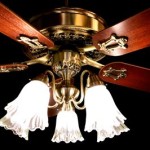How To Create Beautiful Ceiling Medallion Stencils
Ceiling medallions are architectural details traditionally used to enhance the aesthetic appeal of lighting fixtures, particularly chandeliers. They provide a focal point on the ceiling, adding a touch of elegance and sophistication to interior spaces. While pre-fabricated medallions are readily available, crafting custom medallion stencils opens avenues for personalized design, allowing for unique expressions of style and integration with existing décor. This article details the process of creating ceiling medallion stencils, covering design considerations, material selection, fabrication techniques, and application methods.
The creation of a ceiling medallion stencil involves several stages, each crucial to the final outcome. These stages encompass conceptualization, design implementation, material preparation, stencil cutting, and finally, the application of the stencil to the ceiling. A meticulous approach to each step ensures a precise and visually striking final product.
Design and Planning for Ceiling Medallion Stencils
The initial phase focuses on design conceptualization. Considerations should be given to the style of the space, the existing architectural elements, and the desired aesthetic. The size of the medallion is paramount; it must be proportional to the room and the lighting fixture it will accompany. A small medallion in a large room may appear insignificant, while an oversized medallion can overwhelm the space. The diameter of the medallion should typically be about one-third to one-half the diameter of the lighting fixture it complements.
The design itself can range from simple geometric patterns to elaborate floral or classical motifs. The complexity of the design directly influences the difficulty of the stencil cutting process. Intricate designs require more precise cutting and can be more prone to tearing or distortion. Simpler designs are generally more forgiving and easier to execute. Researching historical medallion designs and experimenting with different patterns using digital design software can aid in the creative process.
Digital design software, such as Adobe Illustrator or Inkscape (a free alternative), allows for precise creation and manipulation of the medallion design. These programs enable the user to scale the design to the desired size, adjust line thickness, and create the necessary cut-out shapes for the stencil. Crucially, the design must incorporate "bridges" or connecting elements that hold the stencil together. These bridges are thin strips of material that remain uncut, preventing the design from falling apart during the stencil cutting process. The number and placement of these bridges must be carefully considered to maintain the integrity of the design without compromising its aesthetic appeal.
Before proceeding to the cutting stage, it's recommended to print a full-size template of the design. This template serves as a visual aid during the cutting process and allows for final adjustments to the design. It also helps to visualize the final appearance of the medallion on the ceiling.
Material Selection and Preparation for Stencil Creation
The choice of material for the stencil is critical for achieving a clean, durable, and reusable result. Several materials are suitable for creating ceiling medallion stencils, each with its own advantages and disadvantages. Mylar, a polyester film, is a popular choice due to its durability, flexibility, and resistance to solvents and paints. It is available in various thicknesses, with a thickness of 5-7.5 mil (thousandths of an inch) being generally recommended for stencil making. This thickness provides a good balance between flexibility and rigidity, allowing for easy handling and clean paint application.
Acetate is another option, but it is less durable than Mylar and more prone to tearing. However, it is generally less expensive and easier to cut with a craft knife. Acetate is more suitable for single-use or short-term stencil projects. Cardstock can also be used for creating stencils, but it is the least durable option and is only suitable for very simple designs and limited use. Heavy cardstock offers a slightly better lifespan than thinner varieties.
Once the material is selected, it must be properly prepared for the cutting process. Clean the surface of the material with a lint-free cloth to remove any dust or debris. Secure the material to a cutting mat using masking tape. The cutting mat provides a stable surface and protects the work area from damage. It is essential to use a self-healing cutting mat, which is designed to withstand repeated cuts without dulling the cutting blade.
Transfer the printed design template onto the stencil material. This can be done using various methods, such as tracing the design with a fine-tipped permanent marker or using carbon paper. Ensure the template is securely aligned with the stencil material to prevent any discrepancies during the cutting process. If using a digital cutting machine, the design can be directly uploaded to the machine and cut without the need for manual tracing.
The Stencil Cutting Process
The stencil cutting process requires precision and patience. Several tools can be used for cutting stencils, including craft knives, rotary cutters, and digital cutting machines. A craft knife, such as an X-Acto knife, is a versatile tool that allows for intricate cuts. It is essential to use a sharp blade to ensure clean cuts and prevent tearing of the stencil material. Replace the blade frequently to maintain optimal cutting performance.
When using a craft knife, hold the knife at a slight angle and apply consistent pressure. Follow the lines of the design carefully, cutting through the stencil material in a smooth, continuous motion. Avoid stopping and starting frequently, as this can create jagged edges and weaken the stencil. For intricate details, use small, controlled cuts.
A rotary cutter is another option for cutting stencils, particularly for straight lines and curves. Rotary cutters are equipped with a circular blade that rotates as it is moved across the material. They are generally faster than craft knives for cutting straight lines but may be less precise for intricate details. When using a rotary cutter, use a ruler or straight edge as a guide to ensure accurate cuts.
Digital cutting machines, such as those from Cricut or Silhouette, offer the most precise and efficient method for cutting stencils. These machines use a computer-controlled blade to cut the design directly into the stencil material. Digital cutting machines require the design to be uploaded in a compatible file format, such as SVG or DXF. Once the design is uploaded, the machine automatically cuts the stencil according to the specified settings. Digital cutting machines are particularly useful for complex designs that would be difficult or time-consuming to cut by hand.
Regardless of the cutting method used, it is essential to exercise caution and take breaks to avoid fatigue. Always cut in a well-lit area and use a cutting mat to protect the work surface. After cutting, carefully remove the stencil from the cutting mat and inspect it for any imperfections. Use a craft knife or small scissors to trim any frayed edges or loose pieces of material.
With the stencil created, the next step involves preparing the ceiling surface and applying the stencil to create the medallion design. Consistent and careful application of paint is essential for a professional, visually appealing result.

Stenciled Ceiling Medallion

How To Make A Beautiful Lace Diy Ceiling Medallion On Budget From House Home

Decorative Stencil Georgian Ceiling Medallion Wall And Stencils For Diy Home Decor Classical Designs

Ceiling Stencil Medallion Elegant Classical Stencils For Home Decor Wall Medallions

Ceiling Stencil Medallion Elegant Classical Stencils For Home Decor

12 Ideas To Paint A Decorative Focal Point With Medallion Stencils

Ceiling Medallion Stencils Custom Design Paint Modello Designs

Stencils 19th Century Ceiling Stencil Medallion

Medallion Stencil For Ceilings Designer Stencils

Ceiling Medallion Stencils Custom Design Paint Modello Designs
Related Posts








